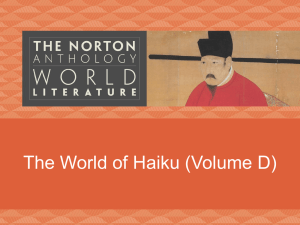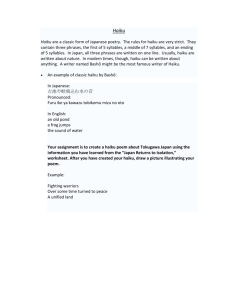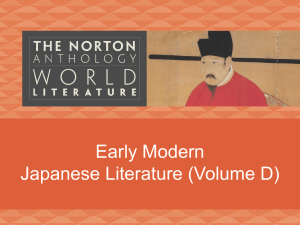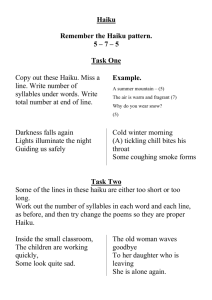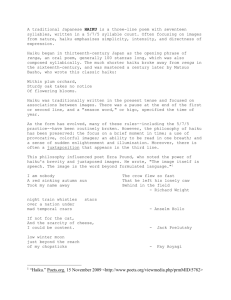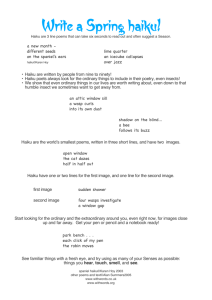atsuo Bashōs Poetic Spaces: Exploring Haikai Intersections M Pargrave Macmillan, $95.00
advertisement
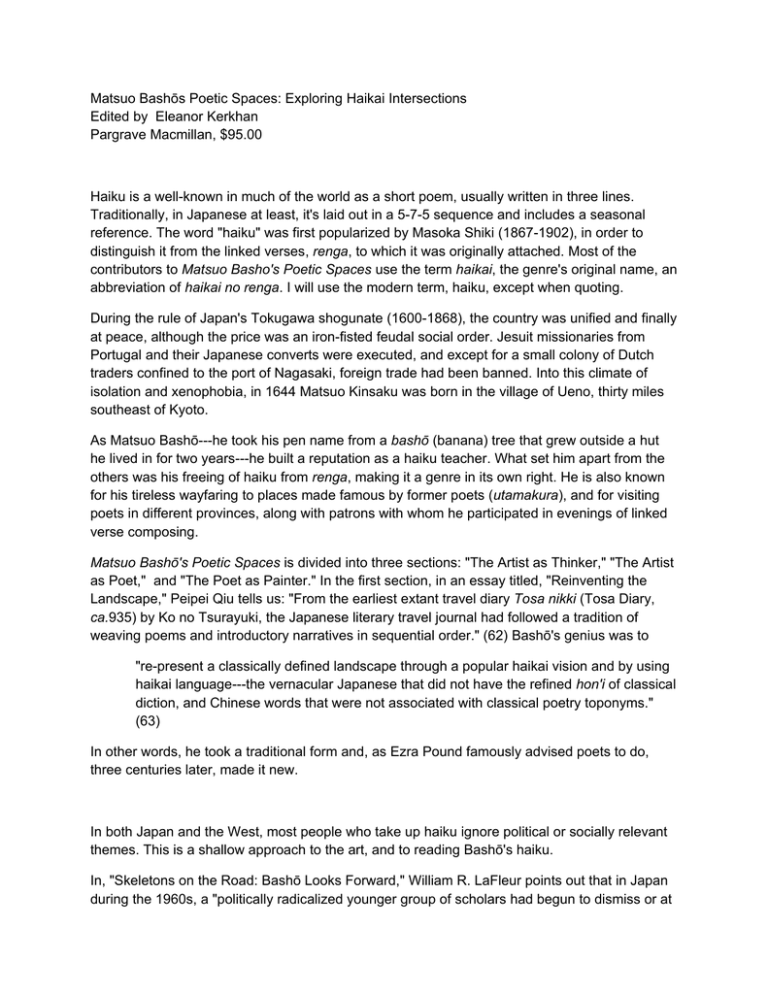
Matsuo Bashōs Poetic Spaces: Exploring Haikai Intersections Edited by Eleanor Kerkhan Pargrave Macmillan, $95.00 Haiku is a well-known in much of the world as a short poem, usually written in three lines. Traditionally, in Japanese at least, it's laid out in a 5-7-5 sequence and includes a seasonal reference. The word "haiku" was first popularized by Masoka Shiki (1867-1902), in order to distinguish it from the linked verses, renga, to which it was originally attached. Most of the contributors to Matsuo Basho's Poetic Spaces use the term haikai, the genre's original name, an abbreviation of haikai no renga. I will use the modern term, haiku, except when quoting. During the rule of Japan's Tokugawa shogunate (1600-1868), the country was unified and finally at peace, although the price was an iron-fisted feudal social order. Jesuit missionaries from Portugal and their Japanese converts were executed, and except for a small colony of Dutch traders confined to the port of Nagasaki, foreign trade had been banned. Into this climate of isolation and xenophobia, in 1644 Matsuo Kinsaku was born in the village of Ueno, thirty miles southeast of Kyoto. As Matsuo Bashō---he took his pen name from a bashō (banana) tree that grew outside a hut he lived in for two years---he built a reputation as a haiku teacher. What set him apart from the others was his freeing of haiku from renga, making it a genre in its own right. He is also known for his tireless wayfaring to places made famous by former poets (utamakura), and for visiting poets in different provinces, along with patrons with whom he participated in evenings of linked verse composing. Matsuo Bashō's Poetic Spaces is divided into three sections: "The Artist as Thinker," "The Artist as Poet," and "The Poet as Painter." In the first section, in an essay titled, "Reinventing the Landscape," Peipei Qiu tells us: "From the earliest extant travel diary Tosa nikki (Tosa Diary, ca.935) by Ko no Tsurayuki, the Japanese literary travel journal had followed a tradition of weaving poems and introductory narratives in sequential order." (62) Bashō's genius was to "re-present a classically defined landscape through a popular haikai vision and by using haikai language---the vernacular Japanese that did not have the refined hon'i of classical diction, and Chinese words that were not associated with classical poetry toponyms." (63) In other words, he took a traditional form and, as Ezra Pound famously advised poets to do, three centuries later, made it new. In both Japan and the West, most people who take up haiku ignore political or socially relevant themes. This is a shallow approach to the art, and to reading Bashō's haiku. In, "Skeletons on the Road: Bashō Looks Forward," William R. LaFleur points out that in Japan during the 1960s, a "politically radicalized younger group of scholars had begun to dismiss or at least downgrade" Bashō, finding him "insufficiently critical of the political structure and powers of his own time."(79) At the same time, in America, especially among the San Francisco Renaissance poets, Bashō was being "celebrated as having incomparable authenticity and the courage to break from a suffocating society in order to see a range of optional personal and societal possibilities."(80) LaFleur relates an incident recorded in the Bashō's first travel journal, "Journal of Bleached Bones in a Field," in which he comes upon an abandoned child, a condition unfortunately very common in those days. After bemoaning its fate, instead of helping the child, he tells it to complain "to 'heaven'." He agrees with Haiku scholar, Yamamoto Kenkichi (1907-1988), who "insisted that what would be moral responsibility in the twentieth century may not be automatically imposed upon a time, place, and societal situation vastly different from our own." (86) Then LaFleur goes through various possible sources that Bashō may have been referring to by his use of the word "heaven" (ten). What I find most relevant to our time is the one that implicates those who administer the regime; e.g., "whatever persons or agencies (that) were responsible for conditions of poverty, infanticide, child abandonment, and the like that the poet came upon while on his travels." (89) In addition, how can this celebrated poem by Bashō be read other than as a commentary on the futility of war? Summer grasses--all that remains of ancient warriors' dreams. Harno Shirane, the author of Traces of Dreams, perhaps the most comprehensive study of Bashō's aesthetics in English, opens the second section of this book with an essay titled, "Double Voices and Bashō's Haikai." He begins with some history. “By the beginning of the seventeenth century, almost all samurai, now the bureaucratic elite, were able to read, as were the middle to upper levels of the farmer and chōnin (middle) classes. This newly literate populance transformed haikai, heterodox linked verse into the first truly popular literature of Japan in the sense of being widely practiced and read by commoners.” (105) This points out how a society's poetry cannot survive without a literate population; in other words, without an education system that doesn’t measure performance with standardized tests, but by individual comprehension and creative interpretation. By the time Bashō was beginning his career as a haiku poet and teacher, “haikai books (over t650 separate titles) were second in popularity only to Buddhist texts among Kyoto publishers, who published an estimated 300,000 volumes in first editions alone.” (105) However, Shirane’s main thesis in this essay is not historical but aesthetical. Drawing on the work of Russian semiotician and literary critic, Mikhail Bakhtin (1895-1975), he points out how, unlike “the thirty-one syllable quintessential classical form” of waka, and the orthodox linked verse of renga, haiku, “which freely drew on colloquial Japanese, regional idioms, Chinese phrases, Buddhist vocabulary, and other centrifugal language, was based on the notion of challenging, inventing, and otherwise subverting” the formality of previous genres. (107) In the same section, Horikiri Minoru focuses on a little discussed aspect of Bashō's poetry; its soundscape, such as in this haiku: After the temple bell stops, its sound continues from the flowers. Strangely, if only in passing, Horikiri mentions Tsunoda Tadanobu and Sano Kiyohiko, who theorized that "Japanese, unlike people of other countries, perceive sounds such as the tinkling of streams and the chirping of birds with the right brain, which processes music, but not with the left one, which processes language." (163-4) Their theory strikes me as racist, and Horikiri, happily, does not pursue it any further. Instead, referring to the many commentaries as to the meaning of Bashō's famous poem: "old pond / a frog jumps in / sound of water (here translated by Cheryl Crowley), he writes: "Were we to compare Bashō's ear to the modern-day ear, physiologically or biologically, we would not see any differences in sensory function; but in terms of social structure and environment, we might think, could it be that our ways of listening to that sound are very different?" (164-5) In the last essay of Section Two, Eleanor Kerkham, the book's editor, launches into a fascinating discussion of novelist and literary essayist Mori Atsushi's "And Me Too, Once Again, Into Oku no hosomichi," a monograph that was commissioned for the 300th anniversary of Bashō's, "Narrow Road to the Deep North." Kerkham tells us that Mori, who died in 1992, "had no special relationship with Bashō or with Oku no hosomichi." (175) However, "(b)oth were creative artists and both brought into being new literary worlds---worlds, as Mori sees them, into which they might lure their readers." (175) Linking to one's creative antecedents is very important, because, even if unconsciously, one's text will always contain revenants, the ghosts in the text. As Kerkham says of Bashō, he "borrows constantly, and his text is a multilayed tapestry of stylistic and structural threads stretching out to many earlier texts.(183) Indeed, what is missing from most modern haiku is the expression of a lineage, and the inclusion of multitude of voices, preventing the poems from having the depth and breadth of ancient haiku. For his presentation, Mori went back to his memories of time spent along the route that Bashō had walked three centuries earlier. (For a similar sojourn, by an Englishwoman, see Lesley Downer's, On the Narrow Road: A Journey into a Lost Japan.) Most importantly, Mori trusted "that in the act of writing he would discover both his subject and its relationship to himself." (174) Here is the process of all creative work: letting one's daemon speak for itself. The last section of Bashō's Poetic Spaces addresses the poet as a visual artist. As with all great creative souls, Bashō saw the whole range of arts and crafts as an expression of the Creative Spirit. Perhaps, if he lived in this century, he would pack a lightweight electronic tablet. One would think that Bashō's paintings would be in the traditional haiga format; e.g., as Joan O'Hara defines it in "Bashō and the Haiga," "a painting (ga) that is accompanied by the inscription of, and is related to the content of, at least one seventeen-syllable verse." (201). While he did produce several dozen haiga, he also painted images that stand alone. Interestingly, there are also paintings by Bashō that contain a poem that has no direct relationship to the picture. This section, which is generously illustrated, includes an essay by Eri F. Yasuhara on the poet/painter Yosa Buson. Born twenty-two years after Bashō's death, "Buson's debt to Bashō is considered almost a matter of historical fact," and relationship that "has not often been subjected to critical analysis." (243) Here is a lovely poem by Buson honoring Bashō: Bashō is gone, and ever afterward, no year has ended as his did. (245) Yasuhara comments: "He has not been able to end any year the way Bashō did, on the road in pursuit of art." (245) I have just brushed the surface of this valuable book, which also contains the work of other scholars equal in insight to those I've briefly discussed. However, before concluding, I'd like to return to the first section, and to the distinguished translator of Bashō, David Landis Barnhill. I will not quote from "Zōka: The Creative in Bashō's View of Nature and Art," his contribution to this book, but from a recent interview with him, published in the on-line journal, Simply Haiku. To American poets in particular, Barnhill is offering an enticing concept he calls "bioreginal haiku," which would "develop over time a shared knowledge of the patterns and characteristics of specific places, just as the Japanese tradition developed over time associations with images, particular seasons, and specific qualities. Readers would need to learn, for instance, not simply the associations of summer evening, but the character of summer evening in the Blue Ridge Mountains, which is different from a summer evening in central Wisconsin or northern New Mexico." (http://simplyhaiku.theartofhaiku.com/autumn-2012-winter2013/features/interview-david-landis-barnhill.html ) For anyone interested Bashō, haiku, or Japanese literature in general, Bashō's Poetic Spaces is a journey worth taking. Rain Taxi Autumn 2013
